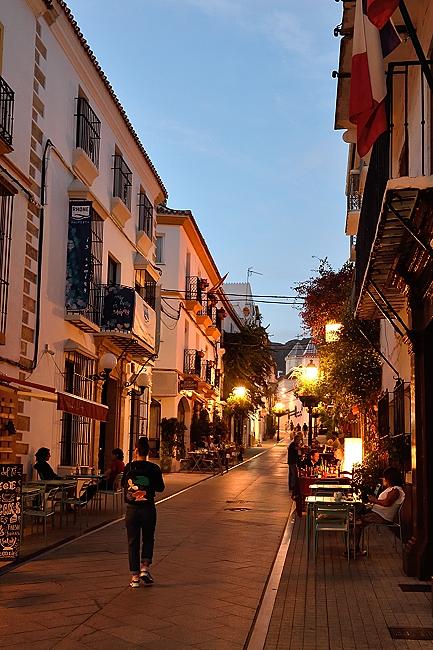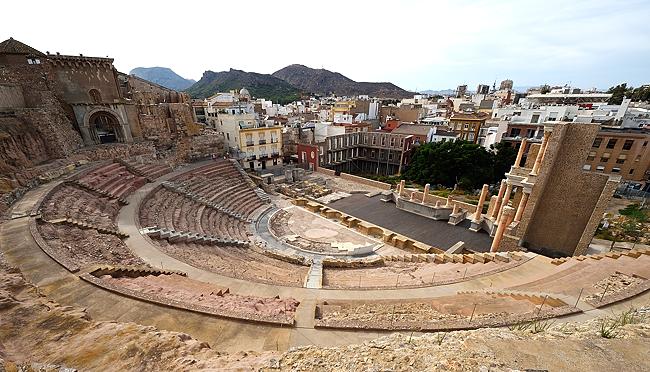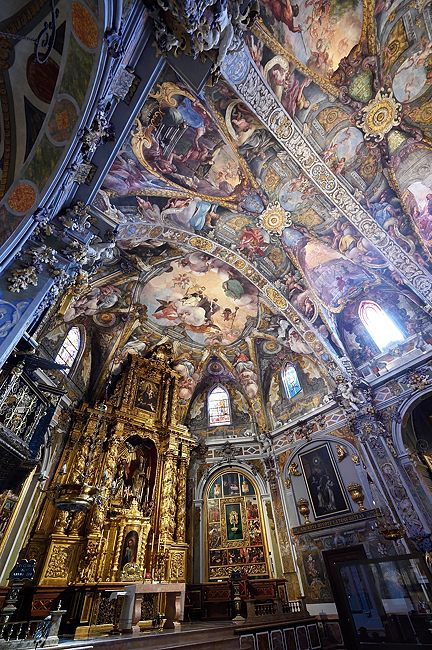Three days, 9/29 – 10/1, from Madrid to Jerez de la Frontera, Cádiz, Marbella, Almería, Cartagena, Alicante, Valencia, then back to Madrid. All behind the wheel of a rental car.
“But why didn’t you take the AVE train for part of the trip?” Spaniards may wonder. “It goes to Sevilla and Valencia. 300 km/h!”
Good idea! In fact, that was exactly what I had tried to do, in an aborted first attempt at this trip on September 22. I rode a zippy AVE from Madrid-Atocha to Sevilla-Santa Justa to pick up my reserved-for-9:30 rental at the train station. Five unhappy hours later, itinerary shot to smithereens, I rode another AVE back home. Gory details at post end.
JEREZ DE LA FRONTERA
Famous for flamenco and sherry that I wasn’t going to sample on a road trip, inhabited since the Neolithic Age, ruled successively by the Romans, Vandals, Visigoths, Moors and now by Spain.

Jerez was on the short list of province-of-Cádiz destinations recommended by Pilar, a Spain native and language exchange regular. She politely shook her head when I showed my original destination list, and instead suggested, along with Jerez:
(♦) Zahara de los Atunes
(♦) Grazalema
(♦) Bolonia
(♦) Sierra de Grazalema Natural Park
(I’d listen up, if I were you. If you think I’m going to pay attention to a muggle-smoking generalist like Rick Steves when I can bag tourist tips from a real Spaniard in Spanish in Spain, you’ve got another think coming. Rick can go nod out in an Algeciras chiringuito, for all I care.)
I visited only Jerez. I quickly understood why Pilar had recommended it, but also saw a tourist quarter decimated by the virus, perhaps more so than in any other town visited. I may return when the hated pandemic ends.

As for the elegant structure above: the Jerez cathedral was built on the ruins of the Great Mosque of Jerez in the eighty-three years from 1695 to 1778 (when I presume that construction crews were paid by the hour), promoted to cathedral status only in 1980. I like the mysterious Willtron’s exterior shot better than any I took.
CÁDIZ
The city, not the province. Founded by the Phoenicians three millenia ago, and No. 10 on Wikipedia’s list of oldest continuously inhabited cities in Europe.

The Cádiz of today seems to have gone full tourist, quite agreeably so, although I didn’t snap my long-term losing streak for pre-trip research on restaurants: this time I couldn’t even find the vegan eatery gushed over on Happy Cow, fear that it may have been another pandemic casualty.
I walked the waterfront, sweated my way to the rooftop viewing deck of the Torre Tavira, which I recommend to hardy sightseers, but not to photographers. Here’s a sample of what can be framed in a photo taken there. Our tastes may differ.
MARBELLA
Marbella is widely associated with the international jet set. Sean Connery once owned a manse here; Antonio Banderas, Simon Cowell, and (shudder) Vladimir Putin do today. I could drop many more names, but shall punt to marbellagoldenmile.com, let them do the releasing-of-monikers for me.

Locals adapt to the preferences of their bucks-up visitors. “In some parts of Costa del Sol,” a Spaniard once told me, “you’ll hear English spoken more often than Spanish.” A past employee at a Marbella bookstore told me that clients routinely queried staff in English, without even a perfunctory ¿Habla inglés? beforehand.
I might be eager to dislike such a place, but would struggle to do so successfully here. The rich and famous know their beach towns. Marbella was a trip highlight, and also struck me as a town almost unaffected by the pandemic. Lots and lots of folk out and about, although virtually all were appropriately masked.

I shacked up at Hotel Villa Marbella, which lives on one of many old town streets closed to car traffic, set out at dusk to explore, and soon settled in at an outdoor table at the serendipitously stumbled-upon Café Cortes. There I passed several hours in the dreamy milieu shown in these photos (while occasionally ordering something, so Café Cortes staff wouldn’t give me the heave). Transitophile.com officially recommends the veggie pizza.
A ridiculously long link from Google Street View shows the daytime scene. That’s my unyoked-from-time spirit you see, seated at the table under the Pintxos sign.
ALMERÍA
I visited this medium-sized coastal city mostly to wander inside the Alcazaba, a thousand year old military fortress that caliph Abd al-Rahman III tossed up in the foothills in the Al-Andalus era. I berthed the buggy at Parking Plaza Marin, needed only ten minutes for the walk and entered for free, thanks to my Spain residency.
Es muy, muy grande, that Alcazaba. Expect to spend a bare minimum of an hour here, and perhaps to rub whiskers with one of the fortress’ many friendly kitties.

I have written in past ‘road trip’ posts that the Google Navigator app sometimes stumbles on Spain’s road grid. It had behaved admirably from Madrid to Almería, but lost its marbles when asked to direct me from the Plaza Marin garage to Cartagena. Around and around the app led me on the nabe’s precariously narrow streets, only to take me right back to Parking Plaza Marin fifteen minutes later.
No fun. I bailed when I realized that the perky-voiced narrator was about to send me on a second trip on this route-to-nowhere, exited the software loop by driving east toward nothing in particular for several kilometers, then tapped in fresh directions to help the intoxicated app break free of delusion. It sobered up, sent me to Cartagena.
CARTAGENA
Eight centuries younger than Cádiz and also founded by the Phoenicians … specifically, by Hasdrupal the Fair, who was assassinated despite that Summer of Love name. Cartagena is a major naval station, capital of the Spanish Navy’s Department of the Mediterranean since 18th century Spanish Bourbons days. Still, like Cádiz, it struck me as a burg that has gone full tourist, and, like Cádiz, attractively so.

I headed straightaway to Teatro Romano, and likely was able to frame this people-free shot because the pandemic has so thinned visitor ranks. Minutes 1 through 3 of this video show the Cartagena I might have seen without the virus.
I stayed at the NH Cartagena, and there enjoyed my first-ever pandemic breakfast buffet. We guests did not wander down at any old hour, grab a plate and start shoveling on the vittles, as is the norm at other times.

Nope: we each had timed reservations, stood in a Covid-distanced line, voiced our preferences to a masked server behind a barrier. Very well done! I had booked the first morning slot at 7:00, dined beside military personnel, who must also be early risers.
ALICANTE
I offer no photos of Alicante.
Alicante’s star tourist attraction is the center-of-town Castillo de Santa Bárbara, crowning Mount Benacantil. ‘Star’ may not be strong enough. Nearly 8,500 TripAdvisor reviewers have described visits there. The closest in-city competitor is the Alicante Tram, with fewer than half as many write-ups.
One may hike up Mount Benacantil. Takes about an hour. The less energetic will favor a ride on the elevator, accessed from beach level. I counted myself among the less energetic, especially given the day’s expected 30°C temps, had investigated both elevator ingress location and a rather distant parking lot. I braved formidable Alicante traffic to get there, immobilized the jalopy, hiked twenty minutes, found the beach level ingress …
… and stared at a sign proclaiming the elevator to be closed.
Perhaps the long drive had sapped a few brain cells. I didn’t investigate alternative routes, turned, marched back to the parking garage, left town.
VALENCIA
Would’ja just look at that bóveda?! Were these Spanish Empire types serious about their ceilings or what? Antonio Palomino designed the artwork about three hundred thirty years ago. Dionis Vidal did the painting. If the ghost of either of these guys crashes a modern art class and challenges anyone to so much as a fingerpainting contest, well, I’d put away the watercolors and make myself scarce. They did not play with paintbrushes in 1693.

This visit to Valencia’s Church of San Nicolás de Bari was another trip highlight, especially for my camera. The structure began life as a parish church in the thirteenth century, went Gothic in the fifteenth and bagged the show-stopping paint job shown in the late seventeenth. A major restoration wrapped up in 2016. “Valencia’s Sistine Chapel” is the title given by some, with reason. It seems downright criminal that I could waltz in without waiting in an appropriately long line, Covid or no Covid. I was almost alone in there.
The AVE goes to Valencia. Less than two hours from Madrid, fifty euros, eight trains a day (and one Alvia that’s almost as speedy), to a Renfe station near Valencia’s center. This was an untaken Spain transit trip that I decided to squeeze into the end of this road trip itinerary.

A mistake. I would have enjoyed visiting by transit far more, although this was partly because I’d so bungled pre-trip research on a parking spot. The garage chosen was a full twenty minute hike from the tourist quarter, along unappealing, traffic-clogged streets in summer heat, and finding the entrance had been like a first effort with a Rubik’s cube. Awful, and all avoidable.
A sidebar: Since posting Spanish Film for Spanish Students, no fewer than three Spaniards have told me that they strongly associate the superb political thriller El Reino with the past antics of Valencia’s Popular Party. I half expected to see antihero Manuel López-Vidal stepping out of the shadows of San Nicolás, pocketing a thick envelope.
The Google Navigator threw another ing-bing on the freeway back to Madrid, began insisting repeatedly that I pull a U turn in 500 meters, or something similarly delirious. I had both hands on the wheel at 120 km/h, couldn’t take notes.
The app gave up, fell silent, then abruptly commanded me to take exit whatever and go bouncing off on a service road. HAL, I thought, while remembering the demented computer from 2001: Space Odyssey; I’m being guided by HAL. The app’s going to tell me it has the greatest enthusiasm for my trip while coaxing me to do an Evel Knievel off a cliff on the A3. I stared resolutely at the Madrid xxx km sign on the freeway, grit teeth, ignored HAL and continued past the indicated exit.
I should have listened. I hit a major construction work road closure a few kilometers later, had to go trundling along on a meandrous detour with the rest of the northbound drivers. The contrite Navigator behaved for the rest of the trip.
The Madrid-Sevilla AVE I rode on September 22 to pick up a rental car — or at least to try to pick up a rental car — was the first Renfe long distance train boarded since the pandemic. Passengers in my coach had been grouped to one side of the wagon, perhaps to ease the chores of cleaning crews. It grated a bit to be surrounded by fellow riders while staring at rows of free seats on the other side of the coach … but everyone wore masks, and I spotted several disinfectant-wielding staffers making the rounds in the already squeaky-clean train during the trip.

The AVE arrived on schedule. I found the Enterprise office in a nearby parking lot, presented my 9:30 a.m. reservation.
The branch manager had bad news for me: no car.
“When will you get one?”
“Two hours.”
I tried another agency. They had a car, all right, and quoted a price more than double the price given by Enterprise. I didn’t try anyone else. My reading of online reviews had suggested a sketchy business, with occasional hard-sells of unneeded insurance, overcharges, other problems. I didn’t want to book with an outfit I hadn’t researched.
Two hours came, went. No wheels.
“We should have a car for you by 12:30.”
They didn’t. Three hours late now. No encouraging signs. My trip itinerary was already kablooie. Might I be marooned in Sevilla overnight?

I returned to the Santa Justa station, bought a return trip to Madrid on the reliable, on-time, much-faster-than-a-car AVE. Later that day, I emailed Enterprise to ask for advice to avoid similar problems in the future. No answer.
No car rental agency had ever before so stranded me, but a subsequent study of online reviews suggests that I may have been lucky. If my travel plans are going to be kicked in the gutter, I’d much rather that the kicking occur in Madrid, a subway ride away from home. (And I haven’t had trouble picking up a rental at Madrid Chamartin.) But I felt ridiculous driving six hours to Jerez, and would feel still more ridiculous starting from Chamartin for a possible Catalonia/Pyrenees trip, just to be sure that I won’t be told “Maybe in three hours” by another car rental agency staffer in Girona.
I also wonder if my straphanging years have whittled away at unconscious psychological adaptations to the rigors of driving. I remember too many stressful episodes during this trip, all of them road-related: escaping a traffic jam, trying to find a parking garage, dealing with some roundabouts. Any unfamiliar city can be a challenge to navigate, true, and Spain cities are tougher to drive than California equivalents (aside from some blocks of downtown San Francisco).
But I think that part of the problem was internal. I drove everywhere in my twenties; today, I turn an ignition key only for occasional rental car road trips like this one. I may have lost an adaption, and am grateful to live in a city that doesn’t force me to get it back.
Just wanna look at the pictures? Wish I’d shut up many paragraphs ago? That pleasure can be yours: visit the photo directory:
https://transitophile.com/chango/files/south_coast/
and wield mouse or trackball without inhibition.
